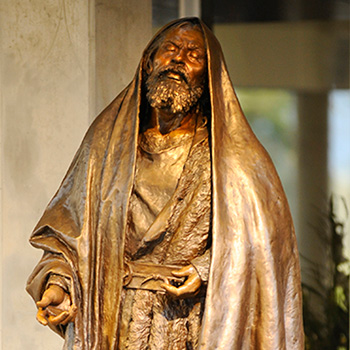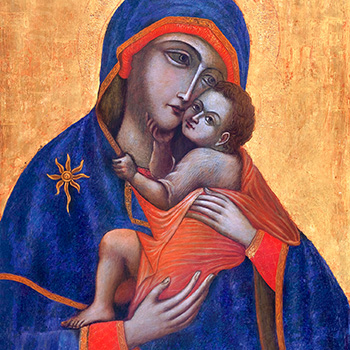As we attempt to follow Christ more closely, we Carmelites find inspiration in the Old Testament Prophet, Elijah, and in the Blessed Virgin Mary.
 The Prophet Elijah
The Prophet Elijah
Elijah's memory was kept alive especially on Mount Carmel where he challenged the people to stop hobbling first on one foot and then on the other but to choose who is God in Israel - Yahweh or Baal. According to the story, which can be found in the First Book of Kings, chapter 18, Elijah's sacrifice was consumed by fire from heaven which proved to the people that Yahweh was the true God.
Elijah in the presence of the Lord on Mount Horeb
Elijah made himself available for God's work and was sent into various situations to proclaim God's word. Elijah undertook a long journey through the desert where he began to despair. He sat down under a bush and wished he were dead but God would not allow him to die and prodded him to continue his journey to Mount Horeb. When he arrived there, God became present to Elijah. God came not with the signs usual in the Old Testament of fire, earthquake and mighty wind but in the sound of a gentle breeze. Elijah was sent back to his people to carry out God's will.
From Elijah, Carmelites learn to listen for the voice of God in the unexpected and in silence. We seek to allow the Word of God to shape our minds and our hearts so that the way we live and the things we do may be prophetic and therefore faithful to the memory of our father Elijah.
 The Blessed Virgin Mary
The Blessed Virgin Mary
The first hermits on Mount Carmel built a church in the middle of their cells. This was the centre of their lives where they converged each day to celebrate Mass together. This little church they named in honour of Our Lady. By this fact the first group of Carmelites took her as their patroness, promising her their faithful service and expecting her protection and favour. They were proud to bear the title of "Brothers of the Blessed Virgin Mary of Mount Carmel" and they defended this title with vigour when their right to it was challenged.
Mary ever ready to accomplish the wish of God
Mary consented to God's will when she was asked to be the mother of the Saviour. She pondered on the events of her life and was able to see in them the hand of God at work. Mary did not become proud about her unique vocation but instead praised God for looking on her lowliness and doing great things in her. She was with Jesus at the beginning of his public ministry when, at the marriage feast at Cana, she made known to him the simple need, "They have no wine". She was with him as he died and there she became the mother of all believers. At the beginning of the Acts of the Apostles we find Mary gathered in the upper room praying with the other disciples waiting for the outpouring of the Holy Spirit. For us Carmelites, Mary is a constant presence in our lives, guiding us and protecting us as we seek to follow Christ.
The brown scapular has for many centuries summed up the Carmelite's relationship with Our Lady. The scapular is a piece of cloth based on the traditional Carmelite friar's garb. Wearing the scapular is a sign of consecration to Mary, the Mother of God, and is a symbol showing that the person is putting on the virtues of Mary and is being protected by her.
Mary symbolises for the Carmelite everything that we hope for - to enter into an intimate relationship with Christ, being totally open to God's will and having our lives transformed by the Word of God. Carmelites have always thought of Mary as the Patroness of the Order. We seek to live in spiritual intimacy with her so that we can learn from her how to live as God's children.
Elijah and Mary are inspirational figures for all Carmelites. They play a very important part in the life and spirituality of the Order which sees itself as belonging to Mary and looks to Elijah as our spiritual father.














